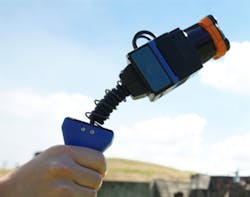Zebedee images Australian leper colony
A joint initiative betweenCSIRO (Highett, Victoria, Australia) and the University of Queensland (Brisbane St. Lucia, Queensland) will see Australian researchers use a mobile laser 3-D mapping system called Zebedee to preserve some of the country's oldest and culturally significant heritage sites.
The Zebedee system, which was developed at CSIRO, can scan an environment as an operator walks through it. The system produces a 3-D map as well as an accurate record of the trajectory followed. The primary sensing technology is LiDAR (Light Detection and Ranging), in which an infrared laser measures ranges to surfaces in the environment.
With the assistance of Queensland Parks and Wildlife Services, the research team has already collected data from a number of heritage sites including the 19th century Brisbane River defenses at Fort Lytton and Peel Island's leper colony buildings.
"This technology is ideal for cultural heritage mapping, which is usually very time consuming and labor intensive. It can often take a whole research team a number weeks or even months to map a site with the accuracy and detail of what we can produce in a few hours," says Dr. Jonathan Roberts, director of CSIRO's autonomous systems lab.
"Zebedee has allowed us to capture a detailed record of several key cultural heritage sites ranging from those which are fragile and risk of damage through natural disasters to those which are remote and difficult to get to," says Professor John Macarthur, dean and head of the school of architecture at the University of Queensland.
The researchers will use the maps to create an archive of data about cultural heritage sites, which will allow them to analyze them without costly and time consuming hand measuring.
As an example, the detailed map of Peel Island's many small buildings allowed the researchers to analyze architecture used to racially segregate people within the leper colony. “The point cloud data clearly depicts how cramped and crowded the living quarters for indigenous people were, when compared to the non-indigenous people who lived in their own huts with scenic verandas," says Professor Macarthur.
More details can be found here.
Related items from Vision Systems Design that you might also find of interest.
1. Lidar system scans mineshafts
Canada-based Sight Power is working with Shaft Sinkers Holdings and Parsec to develop a Mobile Shaft Scanning System (MS3) that will fully automate the inspection of mineshafts.
2.Irish cliffs surveyed with Lidar
When chartered land surveyors at Coastway (Co. Kildare, Ireland) were given the task of laser scanning and producing a 3-D model of the cliffs of Moher on the western seaboard of County Clare Ireland, they approached Measurement Devices Ltd (MDL; York, England) to assist them with the task.
3.Lidar unveils possible Honduran archaeological ruins
A team from the University of Houston (UH; Houston, TX, USA) and the National Science Foundation (NSF) National Center for Airborne Laser Mapping (NCALM; Houston, TX, USA) has mapped a remote region of Honduras that may contain the legendary lost city of Ciudad Blanca.
-- Dave Wilson, Senior Editor,Vision Systems Design
